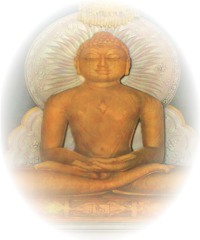 |
 |
|
| MAHAVIR
JAYANTI |
|
|
|
|
|
| On the 13th day of the bright fortnight of
Chaitra Mahavir Jayanti (birthday) is celebrated. Vardhaman Mahavir, the 24th
Tirthankar (guide), is the great hero of the Jam religion. He lived from 540 to
468 B.C. Rishabhadeva, the first Tirthankar, is believed to have been the
founder of the Jain religion. Dr Radhakrishnan writes, |
|
| “There is no doubt that
Jainism prevailed even before Vardhaman or Parshvanath.” In the 12th century
A.D. King Kumarapala was won over to Jainism and made Gujarat a model Jam
state. Today the followers of the lain religion form a community of more than
one million and a half living in India. |
 |
|
|
| Mahavir is the “Jina” or
“Conqueror”, under whose guidance his devotees are encouraged to conquer the
karma-rebirth cycle, this being the goal of the lain religion. Mahavir was a
kshatriya prince (warrior caste) of North Bihar in Northern India. At the age
of 30 he became a wandering ascetic. Thirteen years later he reached
illumination. His followers form four orders: monks (muni or sadhu), nuns
(sadhvi), laymen (shravaka) and lay-women (shravika). |
|
Digambaras and Shvetambaras
Around the year 80 AD the Jains split into two sects:
Digambaras (space clothed) and Shvetambaras (clothed in white). Digambaras hold
that sadhus must be naked as a sign of total renunciation. Other doctrines held
by the Digambaras but rejected by the Shvetambaras are 1. Only men can obtain
final liberation (moksha), women must be reborn as men. 2. The images of the
Tirthankars must be represented with downcast eyes, nude and unadorned. 3.
Mahavir never married. 4. Once the highest stage of knowledge is reached, a
saint can sustain life without eating, and 5. By the 2nd century AD the entire
canon of sacred books was lost. |
|
Dash laxanparva
The holiest feast of the Jains is Dashlaxanparva, which is
celebrated by the Digambaras from the 5th to the 14th of the bright half of
Bhadrapad. During these days there is an atmosphere of joy in every lain
temple. Every day in the morning after taking bath all men and women go to
worship in the temple. Then each day there is a lecture on each of the ten
chapters of the holy book “Shritatvarth Sutra”. These ten chapters dwell on the
following ten duties (dharma): 1. Kshama (forgiveness), 2. Mardava (humility),
3. Arjava (simplicity and frankness). 4. Shaucha (cleanliness), 5. Satya
(truthfulness), 6. Samyama (self-control), 7. Tap (austerity), 8. Tyag
(renunciation). 9. Akimchanya (detachment), and 10. Bramhacharya (celibacy). On
the day dedicated to “tyag” gifts are offered to social service institutions,
and on the first day of the dark half of Ashvin, at the end of the celebration,
all the men come together and embracing each other they ask pardon for the
of-fences committed during the past year. |
|
| The 14th day of the bright
half of Bhadrapad is known as Anant Chaturdashi (endless fourteenth). This is a
very important day for the Jains, this being the last day of the
Dashlaxanparva. According to Jam scriptures one can gain much merit by
observing a vow on this day. The Jains of the Shvetambara sect celebrate the
Paryushan Feast, from the 12th of the dark half of Bhadrapad to the 4th of the
bright half of Ashvin. |
|
Ahimsa and Karma
“Ahimsa” or non-hurting” of life is the main principle of
Jainism.
“Even unintentionally and the involuntary stepping on an ant
may have serious consequences for the soul... Not only living things, but
everything in nature must be respectfully treated.”
“There is no place for God in Jainism, which has
con-structed a complicated theory of ‘karma’ and karmic mat-ter. Karma is that
general energy of the soul that causes its attachment to matter and its
subsequent defilement, a kind of link between matter and spirit. All the effort
at liberation, therefore, must be directed to controlling karma, and all by
autonomous activity. Any mediation of divine grace or forgiveness is rejected
as evading the problem of sin, suffering and redemption. Each person must work
out his own deliverance.” According to Jain tradition the wheel of time in this
visible world is forever turning. The flow of time is without beginning and
without end.
Whatever may be said about the philosophy of Jainism, it must be acknowledged
that its practice to a large extent seems to achieve results. |
|
|
|
|
|
|
|
 |
 |
|
 |
 |
|
|
 |
 |
|